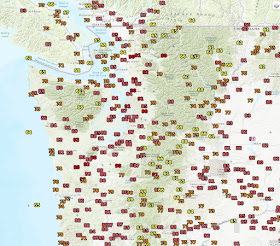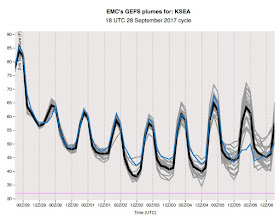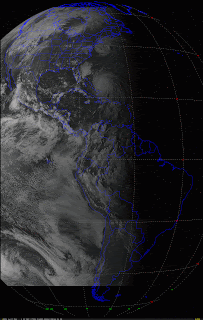The news the past several months has been full of disasters associated with extreme weather and wildfires. Hurricanes Harvey, Irma, and Maria. Flooding in Houston, power outages in Puerto Rico. Wildfires in the Pacific Northwest.
The media and some politicians often suggest that global warming is a major explanation for many of these contemporary disasters. As noted in previous blogs, I believe that scientific evidence and reports by authoritative groups (e.g., the IPCC) suggest a much more nuanced conclusion about global warming's role in
recent weather-related disasters.
Specifically,
global warming has played only a minor role in enhancing some of the recent extreme weather events, and that the current problems are mainly the result of poor infrastructure, inadequate planning, and the lack of resilience. This is particularly true for the Pacific Northwest, downwind of the slowly changing eastern Pacific Ocean.
Our society is not resilient to past and current weather extremes, ones driven overwhelmingly by natural variability and not by human-caused global warming. So instead of the partisan fighting about the impacts of global warming, which has resulted in little progress,
why not work together as a State and a nation to make ourselves more resilient to the current climate and extreme weather?
Furthermore, putting the blame on global warming has allowed politicians, major institutions, and others to shuffle off their responsibilities in allowing inadequate infrastructure and planning regarding to current extreme weather. Easy to point the finger at global warming and not their failings.
Lack of Resilience is Obvious
Outside of the Pacific Northwest.
Houston has had a number of floods during the past few years and it is clear that
lack of planning for heavy rain and abysmal infrastructure has been the primary cause of the problems.
New Orleans flooded during Katrina for many reasons, including inadequate, poorly constructed, and poorly maintained levees, destruction of protecting wetlands, and subsidence from the use of underground aquifers and drilling operations.
In New York City during Hurricane Sandy, subways flooded due to inadequate watertight doors, power failed due to poor placement of electrical infrastructure, and homes located in inappropriate coastal locations were flooded.
In Puerto Rico last week, massive power outages have occurred due to an irresponsibly neglected power system.
In California, the Oroville Dam spillway failed after a heavy rainfall event. Poor construction and lack of maintenance were the key issues.
There is a virtually an unlimited number of examples of this: lack of planning and poor infrastructure has made millions of people vulnerable to current extreme weather.
The Pacific Northwest
Our region has done relatively little to deal with susceptibility to the effects of weather extremes.
Take wildfires and smoke. There has been several major fires during the past several years and a number of media outlets/politicians have been pointing the finger at climate change.
Wrong direction. Temperatures in our region have only warmed up about 1 F during the past several decades and precipitation/snowpack has remained steady over the period (little trend).
But our forests east of the Cascade crest are in terrible condition and prone to burn. We have suppressed fires for over a half-century allowing unhealthy conditions to develop, with lots of debris on the forest floor and excessive density of timber. Invasive cheatgrass (grassoline) has replace much of the less fire-prone natural bunch grass.
Too many people have been allowed to build homes and buildings in and near forests, endangering them and those sent to protect their homes during wildfires.
Our current State leadership has been irresponsible in this area, investing far less in restoring forest health than other states, and even opposing US Forest Service attempts at expanding proscribed burns. Instead, they have pushed an ineffective agenda regarding global warming. And little has been done to discourage building at the urban/forest interface.
Heavy rain, flooding and landslides. Our region can get heavy precipitation during the winter from atmospheric river events, some with 10-20 inches over a few days. The result is flooding near rivers and slope failures . In the future, global warming will enhance the most extreme global rivers by 30-40% (I have done research on this with Mike Warner, of the US Army Corps of Engineers).
Our region is not prepared for even current rain events. Recently, a very modest rain period caused the failure of King County's West Point treatment plant, resulting in a catastrophic ejection of raw sewage into Puget Sound.
The State and local government agencies allow folks to build in vulnerable locations, such as the homes in Oso, WA that were wiped out a few years ago.
Too many people live near rivers in highly vulnerable locations. For example, there are a number of communities living next to rivers, including in bends of rivers (see an example for Big Bend, WA near the Skykomish River, as an example). Disasters waiting to happen.
The State must identify all vulnerable areas to flooding and landslides, prevent future construction at such sites, and begin the process of buying out vulnerable properties. This is will not be cheap, but the process needs to start immediately.
Water Resources
During the past fifty years there has been no downward trend in precipitation or snowpack over the Northwest, although there have been some poor years in one or the other (such as the warm temperatures and poor snowpack of 2015).
Models indicate that global warming will slightly enhance annual precipitation, but significantly reduce April 1 Cascade snowpack by the middle-end of the century. The Columbia River will be less affected by the warming since many of its sources are from higher terrain.
During the 2015 warm summer, water resources were stretched for the Yakima Valley and for some cities near the Olympics. There were substantial agricultural losses. To deal with these issues, more efficient use of water in agriculture (e.g, more drip irrigation, less water-intensive crops, reduce loss/waste) is needed as well as enhanced reservoir capacity, something this being discussed/planned as part of the
Yakima Valley Integrated Water Management Plan. A statewide plan for dealing with occasional dry years is needed immediately, with extensive planning and infrastructure development for the second half of the century when temperatures will be warmer (more evaporation) and snowpack will decline.
A Key Resource for Resilience and Adaptation: Knowing the Past and Future
To take the necessary steps to make our region more resilient to the current climate and to prepare for future changes, society needs information on the nature of historical extremes and our best projections of what will occur as the planet warms.
Unfortunately, our state is not investing sufficiently in these areas.
The Office of the Washington State Climatologist (who is Nick Bond) is acutely underfunded and can not collect and make available comprehensive and up-to-date climate information. The State has not invested in regional climate modeling, an effort that
several of us have been trying to spin up. A modest State investment in documenting past climate information and producing improved projections of future climate, will greatly enhance regional resilience efforts.
Emergency Assistance
Finally, resilience also represents the ability of the nation and world to effectively and quickly move in supplies and assistance to locations where disasters occur. How effective we are in this area is being tested in Puerto Rico, whose infrastructure was decimated by Hurricane Maria. The U.S. needs to have a large rapid response infrastructure to bring food, water, and assistance to those facing environmental disasters, and the ability to provide extended assistance with housing and other needs. There has been suggestions that our region is woefully unprepared for the next major earthquake or for an historical record flood.
Many of the above suggestions should be of interest to folks on both sides of the aisle. Don't believe in global warming? You can still support making our society resilient to current extreme weather. You can support getting better climate information. A middle ground is possible...


















































